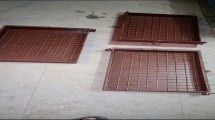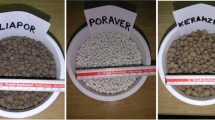Abstract
The aim of the present study is to consider the possibility of using dune sand concrete (DSC) as a replacement for ordinary concrete in lightly loaded constructions such as those used for housing and dwelling. Mineral additives such as limestone fillers are found to influence some of the physical and mechanical properties of the sand concrete and hence will be addressed in this work. Two water/cement ratios were used (W/C = 0.5; W/C = 0.7) to make four types of DSC, two of which containing limestone fillers. The four types of concrete were characterized physico-mechanically, through specimens testing, and subjected to three curing temperatures (20 °C, 35 °C and 50 °C) for the evaluation of their shrinkage. A nonlinear finite element analysis (NLFEA), using ANSYS© software, was carried out to assess the shrinkage of the four types of sand concrete, taking into account both the thermal and mechanical properties of the concrete material. These properties were calculated using the maturity concept and three various two-phase models based on the composite materials theory. The experimental results showed that the incorporation of limestone fillers improved significantly the properties of DSC in both the fresh and hardened states. At the same time, the addition of these fillers increased the shrinkage of DSC without superplasticisers. On the contrary, when limestone fillers were combined with superplastizicers, shrinkage was reduced by 20%. The numerical results on shrinkage obtained from the finite element analysis showed a good agreement with the experimental ones under the different thermal conditions.













Similar content being viewed by others
References
Sablocrete (1994) Béton de Sable: Caractéristiques et pratiques d’utilisation. ENPC France
Chemrouk M, Boukerrou M, Azzaz Rahmani A (2016) Physico-mechanical characteristics of dune sand concrete as an emerging building material for light constructions. In: Proceedings of the 4th International Conference on Civil Engineering and Urban Planning IV: 561–568 https://doi.org/10.1201/b19880-106
Bédérina M, Khenfer MM, Dheilly RM, Quéneudec M (2005) Reuse of local sand: effect of limestone filler proportion on the rheological and mechanical properties of different sand concretes. Cem Concr Res 35:1172–1179. https://doi.org/10.1016/j.cemconres.2004.07.006
Benamara D, Tebbal N, Rahmouni ZEA (2019) Durability of high performance sandcretes (HPS) in aggressive environment. Adv Concr Constr 8:199–206
Belhadj B, Bederina M, Benguettache K, Queneudec M (2014) Effect of the type of sand on the fracture and mechanical properties of sand concrete. Adv Concr Constr 1:013
Itim A, Ezziane K, Kadri E-H (2011) Compressive strength and shrinkage of mortar containing various amounts of mineral additions. Constr Build Mater 25:3603–3609. https://doi.org/10.1016/j.conbuildmat.2011.03.055
Bederina M, Gotteicha M, Belhadj B, Dheily R, Khenfer M, Queneudec M (2012) Drying shrinkage studies of wood sand concrete–Effect of different wood treatments. Constr Build Mater 36:1066–1075. https://doi.org/10.1016/j.conbuildmat.2012.06.010
Aly T, Sanjayan JG (2008) Factors contributing to early age shrinkage cracking of slag concretes subjected to 7-days moist curing. Mater Struct 41:633–642. https://doi.org/10.1617/s11527-007-9269-2
Kong FK, Evans RH (2017) Reinforced and prestressed concrete. CRC Press. https://doi.org/10.1201/9781315274416
Al-Gburi M. (2015) Restraint effects in early age concrete structures. Luleå tekniska universitet
Neville AM (2006) The properties of concrete. In: MEANJIN, I. (ed.). Longman London
Rao GA (2001) Long-term drying shrinkage of mortar—influence of silica fume and size of fine aggregate. Cem Concr Res 31:171–175. https://doi.org/10.1016/S0008-8846(00)00347-1
Hadjoudja M, Mesbah HA, Bederina M, Makhloufi Z (2019) Modeling of dimensional variations of a dune sand concrete reinforced by addition of steel fibers. J Adhes Sci Technol 33:2307–2328. https://doi.org/10.1080/01694243.2019.1641176
Bendjillali K, Chemrouk M, Boulekbache B (2019) Performances of cementitious mortars containing recycled synthetic fibres under hot-dry climate. Eur J Environ Civ Eng 23(10):1235–1247. https://doi.org/10.1080/19648189.2017.1344152
Brooks JJ (2000) Elasticity, creep, and shrinkage of concretes containing admixtures. Spec Publ 194:283–360
Al-Saleh SA, Al-Zaid RZ (2006) Effects of drying conditions, admixtures and specimen size on shrinkage strains. Cem Concr Res 36:1985–1991. https://doi.org/10.1016/j.cemconres.2004.11.005
Toledo Filho RD, Ghavami K, Sanjuán MA, England GL (2005) Free restrained and drying shrinkage of cement mortar composites reinforced with vegetable fibres. Cement Concr Compos 27:537–546. https://doi.org/10.1016/j.cemconcomp.2004.09.005
Bendjillali K, Chemrouk M, Goual MS, Boulekbache B (2013) Behaviour of polypropylene fibre mortars conserved in different environments. Eur J Environ Civ Eng 17:687–699. https://doi.org/10.1080/19648189.2013.812685
Lahmar N, Bouziadi F, Boulekbache B, Meziane E-H, Hamrat M, Haddi A, Djelal C (2020) Experimental and finite element analysis of shrinkage of concrete made with recycled coarse aggregates subjected to thermal loading. Constr Build Mater 247:118564. https://doi.org/10.1016/j.conbuildmat.2020.118564
Bouziadi F, Boulekbache B, Haddi A, Djelal C (2018) Experimental and finite element analysis of creep behaviour of steel fibre reinforced high strength concrete beams. Constr Build Mater 173:101–110. https://doi.org/10.1016/j.conbuildmat.2018.04.013
Wu S, Huang D, Lin F-B, Zhao H, Wang P (2011) Estimation of cracking risk of concrete at early age based on thermal stress analysis. J Therm Anal Calorim 105:171–186. https://doi.org/10.1007/s10973-011-1512-y
NF P18–452 (1988) Norme française pour la mesure du temps d’écoulement des bétons et des mortiers aux maniabilimètres (French standard)
EN 12390–3 (2003) Part 3: Compressive strength of test specimens
EN 12390–5 (2001) Part 5: Flexural strength of test specimens
ASTM C469 (2014) Standard test method for static modulus of elasticity and Poisson’s ratio of concrete in compression. ASTM International, West Conshohocken, PA
Bouziadi F, Boulekbache B, Hamrat M (2016) The effects of fibres on the shrinkage of high-strength concrete under various curing temperatures. Constr Build Mater 114:40–48. https://doi.org/10.1016/j.conbuildmat.2016.03.164
Zhang P, Li Q-f (2013) Effect of polypropylene fiber on durability of concrete composite containing fly ash and silica fume. Compos B Eng 45:1587–1594. https://doi.org/10.1016/j.compositesb.2012.10.006
Luo FJ, He L, Pan Z, Duan WH, Zhao XL, Collins F (2013) Effect of very fine particles on workability and strength of concrete made with dune sand. Constr Build Mater 47:131–137. https://doi.org/10.1016/j.conbuildmat.2013.05.005
Rahmani AA, Chemrouk M, Ammar-Boudjelal A (2020) Rheological, physico-mechanical and durability properties of multi-recycled concrete. Adv Concr Constr 9(1):9–22
Chemrouk M, Hamrat M (2002) High performance concrete – Experimental studies of the material. Innovations and Developments In Concrete Materials And Construction
Aquino C, Inoue M, Miura H, Mizuta M, Okamoto T (2010) The effects of limestone aggregate on concrete properties. Constr Build Mater 24:2363–2368. https://doi.org/10.1016/j.conbuildmat.2010.05.008
Jiang C, Yang Y, Wang Y, Zhou Y, Ma C (2014) Autogenous shrinkage of high performance concrete containing mineral admixtures under different curing temperatures. Constr Build Mater 61:260–269. https://doi.org/10.1016/j.conbuildmat.2014.03.023
Maruyama I, Teramoto A (2013) Temperature dependence of autogenous shrinkage of silica fume cement pastes with a very low water–binder ratio. Cem Concr Res 50:41–50. https://doi.org/10.1016/j.cemconres.2013.03.017
Bjøntegaard Ø, Hammer T, Sellevold EJ (2004) On the measurement of free deformation of early age cement paste and concrete. Cement Concr Compos 26:427–435. https://doi.org/10.1016/S0958-9465(03)00065-9
Sant G (2012) The influence of temperature on autogenous volume changes in cementitious materials containing shrinkage reducing admixtures. Cement Concr Compos 34:855–865. https://doi.org/10.1016/j.cemconcomp.2012.04.003
Kovler K, Zhutovsky S (2006) Overview and future trends of shrinkage research. Mater Struct 39:827–847. https://doi.org/10.1617/s11527-006-9114-z
ANSYS (2013) Release 15.0, Mechanical User’s Guide
Bouziadi F, Boulekbache B, Haddi A, Djelal C, Hamrat M (2018) Numerical analysis of shrinkage of steel fiber reinforced high-strength concrete subjected to thermal loading. Constr Build Mater 181:381–393. https://doi.org/10.1016/j.conbuildmat.2018.06.054
Carino NJ, Lew HS (2001) The maturity method: from theory to application. Struct Congr Expo Wash. https://doi.org/10.1061/40558(2001)17
Chu I, Kwon SH, Amin MN, Kim J-K (2012) Estimation of temperature effects on autogenous shrinkage of concrete by a new prediction model. Constr Build Mater 35:171–182. https://doi.org/10.1016/j.conbuildmat.2012.03.005
MC2010 (2013) fib Model Code for Concrete Structures. Ernst & Sohn Publishing Company, Lausanne, Switzerland
Tazawa E-i (1999) Effect of constituents and curing condition on autogenous shrinkage of concrete. CRC Press, Autogenous Shrinkage of Concrete. https://doi.org/10.1201/9781482272123
Liu K, Lu L, Wang F, Liang W (2017) Theoretical and experimental study on multi-phase model of thermal conductivity for fiber reinforced concrete. Constr Build Mater 148:465–475. https://doi.org/10.1016/j.conbuildmat.2017.05.043
Zhang W, Min H, Gu X, Xi Y, Xing Y (2015) Mesoscale model for thermal conductivity of concrete. Constr Build Mater 98:8–16. https://doi.org/10.1016/j.conbuildmat.2015.08.106
Kim K-H, Jeon S-E, Kim J-K, Yang S (2003) An experimental study on thermal conductivity of concrete. Cem Concr Res 33:363–371. https://doi.org/10.1016/S0008-8846(02)00965-1
Shen D, Jiang J, Shen J, Yao P, Jiang G (2015) Influence of prewetted lightweight aggregates on the behavior and cracking potential of internally cured concrete at an early age. Constr Build Mater 99:260–271. https://doi.org/10.1016/j.conbuildmat.2015.08.093
Balaji A, Muhamed Luquman K, Nagarajanb P, Pillai TM (2016) Prediction of response of reinforced concrete frames exposed to fire. Adv Comput Des 1:105–17
Dahmani L (2011) Thermomechanical response of LNG concrete tank to cryogenic temperatures. Strength Mater 43:526–531. https://doi.org/10.1007/s11223-011-9323-8
Mohammadi T, Wan B, Foley CM (2015). The Role of Shrinkage Strains Causing Early-Age Cracking in Cast-in-Place Concrete Bridge Decks. ACI Special Publication: 123–140
Bouziadi F, Boulekbache B, Haddi A, Hamrat M, Djelal C (2020) Finite element modeling of creep behavior of FRP-externally strengthened reinforced concrete beams. Eng Struct 204:109908. https://doi.org/10.1016/j.engstruct.2019.109908
Hamrat M, Bouziadi F, Boulekbache B, Daouadji TH, Chergui S, Labed A, Amziane S (2020) Experimental and numerical investigation on the deflection behavior of pre-cracked and repaired reinforced concrete beams with fiber-reinforced polymer. Constr Build Mater 249:118745. https://doi.org/10.1016/j.conbuildmat.2020.118745
Tahenni T, Bouziadi F, Boulekbache B, Amziane S (2021) Experimental and numerical investigation of the effect of steel fibres on the deflection behaviour of reinforced concrete beams without stirrups. Structures 33:1603–1619. https://doi.org/10.1016/j.istruc.2021.05.005
Tahenni T, Bouziadi F, Boulekbache B, Amziane S (2021) Experimental and nonlinear finite element analysis of shear behaviour of reinforced concrete beams. Structures 29:1582–1596. https://doi.org/10.1016/j.istruc.2020.12.043
Abu-Obeidah A, Hawileh RA, Abdalla JA (2015) Finite element analysis of strengthened RC beams in shear with aluminum plates. Comput Struct 147:36–46. https://doi.org/10.1016/j.compstruc.2014.10.009
Bouziadi F, Boulekbache B, Tahenni T, Haddi A, Hamrat M, Amziane S (2022) Finite element analysis of steady-state uniaxial basic creep of high-performance concrete. J Build Eng 52:104500. https://doi.org/10.1016/j.jobe.2022.104500
Acknowledgements
The authors wish to acknowledge the financial support provided by the Ministry of Higher Education and Scientific Research of Algeria, to carry out the research work at the University of Science and Technology Houari Boumediene (USTHB).
Author information
Authors and Affiliations
Corresponding author
Ethics declarations
Conflict of interest
The authors declare that they have no conflict of interest.
Additional information
Publisher's Note
Springer Nature remains neutral with regard to jurisdictional claims in published maps and institutional affiliations.
Rights and permissions
Springer Nature or its licensor holds exclusive rights to this article under a publishing agreement with the author(s) or other rightsholder(s); author self-archiving of the accepted manuscript version of this article is solely governed by the terms of such publishing agreement and applicable law.
About this article
Cite this article
Ladjel, M., Chemrouk, M., Bouziadi, F. et al. Experimental and numerical investigation of the shrinkage of dune sand concrete containing limestone fillers subjected to different curing temperatures. Mater Struct 55, 200 (2022). https://doi.org/10.1617/s11527-022-02033-4
Received:
Accepted:
Published:
DOI: https://doi.org/10.1617/s11527-022-02033-4




